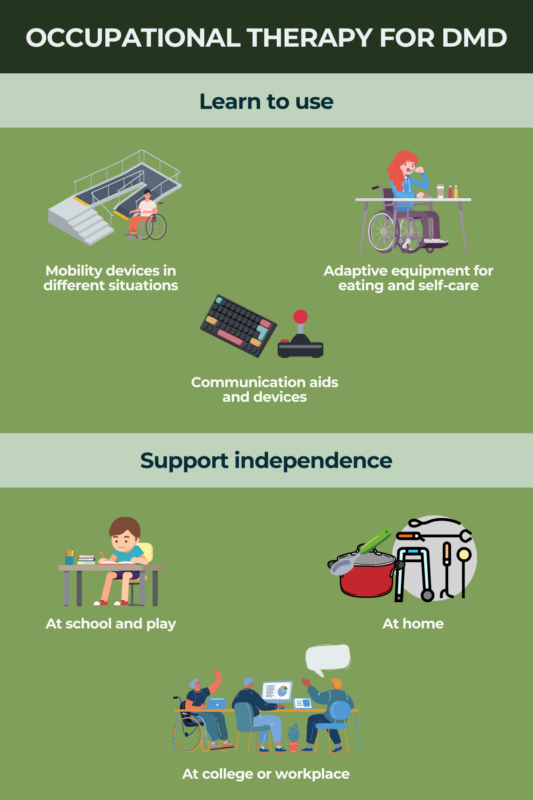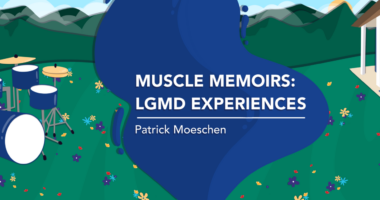Empowering abilities: Occupational therapy and DMD
Last updated June 21, 2024, by Susie Strachan

Occupational therapy can help people with Duchenne muscular dystrophy (DMD) maintain and improve the skills needed for managing daily life.
DMD is a genetic disorder characterized by progressive muscle weakness that can affect mobility. Working with an occupational therapist (OT) can be part of a treatment plan as a way to support your independence.
An OT can help you with your motor skills and managing physical tasks, as well as make suggestions for adaptive equipment and modifications for home, school, and work. An OT also can work with caregivers so they know how they can offer assistance.
Understanding DMD occupational therapy
An OT focuses on helping you be able to do activities and tasks that are an important part of your daily life.
Occupational therapy goals at different ages and life stages, such as for school and work, might include:
- children trying to keep up when playing with siblings or friends
- teenagers needing help with fine motor skills for writing or learning to use a walker or wheelchair
- young adults wanting help with self-care tasks, such as grooming and eating, as they become harder to do.
An OT can work with your DMD healthcare team, including a physical therapist or a speech therapist, on:
- activities to maintain muscle strength
- using equipment for self-care tasks, such as commode chairs, shower chairs, beds, and mobile arm supports
- using communication aids and devices such as writing aids or computers to assist with school and work-related activities as well as social networking
- using a corset to provide better support and balance to your spine in the case of scoliosis (an abnormal sideways curvature of the spine)
- using arm slings or orthotic devices to support weak muscles in your wrists, arms, ankles, and shoulders
- using energy conservation techniques so your body movements are more efficient, which can help with fatigue.

Being assessed
During a general assessment, the OT will ask about your medical history, including your diagnosis, progression of symptoms, and any other health conditions.
They also will discuss your typical day-to-day activities, hobbies, leisure activities, and any challenges you face while living with DMD. Parents or caregivers should be involved in the assessment of a child with DMD.
The OT will then do a functional assessment, including an evaluation of your ability to:
- move around, including walking, using a wheelchair, and transferring, such as from a wheelchair to a bed or classroom chair
- manage self-care tasks such as eating, bathing, grooming, and dressing
- move hands and fingers, for tasks such as writing and drawing, buttoning clothes, and using utensils for eating and cooking.
The OT will ask about how you interact with your environment at home, school, or work. This can help them identify potential barriers with the goal of making modifications for better accessibility and safety.
You can make your appointment more productive if you do some prep work in advance by thinking about:
- your daily routine
- specific challenges or tasks you find difficult
- questions about improving daily activities
- what you hope to achieve with OT support, from daily tasks to educational aspirations and overall improvement in quality of life.
Remember to bring to the appointment your medical records and any mobility aids or assistive devices you currently use.
Benefits of occupational therapy for people with DMD
DMD occupational therapy benefits, such as improved mobility and self-sufficiency, can help you continue to participate in activities and be independent.
An OT can help you throughout all stages of your life and DMD progression. In general, they can:
- assess and recommend adaptive equipment, such as modified utensils, dressing aids, specialized seating
- suggest modifications to your home, school, and work environments, such as installing grab bars and ramps, widening doorways, or lowering countertops and cupboards
- work with you on manual dexterity to maintain hand strength and coordination
- work with you on cognitive exercises to maintain mental focus.
Young and school-age children
For young children with DMD, an OT can help a child reach developmental milestones, especially in tasks that require fine motor skills. An OT might:
- use play-based exercises to work on motor skills and social interactions
- recommend adaptive techniques for daily self-care activities such as dressing and eating
- help prepare for school by working with educators to put supports in the classroom.
For school-age adolescents with DMD, an OT can work with parents and guardians on navigating school. For example, an OT can help write and update an individualized educational program that outlines all necessary accommodations and supports.
They also can identify the supports that should be put in place. To help with doing school work as independently as possible, they may request:
- extra time for school assignments
- adaptive classroom equipment, such as pencils and pens with adapted grips and supportive seats that may include harnesses, lateral supports, and headrests.
Schools for children with special needs often have an OT and a physical therapist on staff or on call to provide assessments and develop plans for students.
Teenagers
During the teenage years, an OT continues to provide support at school and look ahead to making the transition to being an adult. They can help a teen learn to use:
- mobility aids such as a power wheelchair
- assistive technology such as voice-activated software, laptops with larger keyboards and adapted mouse or joystick, and speech-to-text programs
- positioning aids to help prevent pressure sores, or standing frames to help maintain posture and circulation
- grab bars, raised toilet seats, or a toilet lift in the school’s bathrooms.
An OT can help with the transition to adulthood by working on:
- developing effective time management and organizational skills to handle daily routines and responsibilities
- managing household chores such as cooking, cleaning, and laundry
- improving communication and social skills to build and maintain relationships.
Young adults
An OT can help with the transition to adulthood, which may include:
- providing strategies and tools to succeed in the workplace, which might include ergonomic adaptations, assistive technology, and time management techniques
- working with college disability services to ensure appropriate accommodations are in place
- refining independent living skills, such as working with service animals and using public transportation
- encouraging self-advocacy skills for addressing your preferences and needs in healthcare, education, and the workplace
- making suggestions for finding DMD support groups to build a sense of belonging and engagement.
Is occupational therapy the same as physiotherapy?
Occupational therapy and physiotherapy (also known as physical therapy or PT) focus on different aspects of rehabilitation but with a similar goal of maintaining independence.
While OT helps with doing activities such as dressing, bathing, and cooking, PT uses exercises and stretching routines to maintain muscle strength and function and prevent contractures (from tight or shortened muscles).
OT and PT are often used as complementary therapies. The two therapies provide a comprehensive approach to both physical and functional needs.
Here are some of the ways OT and PT are similar:
- Both assess your mobility and provide training to improve movement, balance, and coordination. For example, this might include navigating your environment, such as transferring from bed to a wheelchair.
- Both can help you manage and reduce pain. This can be achieved through exercises, proper positioning, and ergonomic tools, and using heat, cold, or ultrasound on your muscles and joints.
- Both can train you in the use of assistive technology, including wheelchairs and other mobility aids, as well as adaptive tools for everyday use.
Muscular Dystrophy News is strictly a news and information website about the disease. It does not provide medical advice, diagnosis, or treatment. This content is not intended to be a substitute for professional medical advice, diagnosis, or treatment. Always seek the advice of your physician or other qualified health provider with any questions you may have regarding a medical condition. Never disregard professional medical advice or delay in seeking it because of something you have read on this website.
Recent Posts
Related articles






